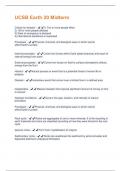UCSB Earth 20 Midterm
Criteria for disaster - ✔️✔️1) Ten or more people killed
2) 100 or more people affected
3) State of emergency is declared
4) International assistance is requested
Processes - ✔️✔️Physical, chemical, and biological ways in which events
affect Earth's surface
Internal processes - ✔️✔️Come from forces within Earth (plate tectonics) and result of
internal energy from earth
External processes - ✔️✔️Come from forces on Earth's surface (atmospheric effects,
energy from the Sun)
Hazard - ✔️✔️Natural process or event that is a potential threat to human life or
property
Disaster - ✔️✔️Hazardous event that occurs over a limited time in a defined area
Catastrophe - ✔️✔️Massive disaster that requires significant amount of money or time
to recover
Geologic Conditions - ✔️✔️Govern the type, location, and intensity of natural
processes
Processes - ✔️✔️Physical, chemical, and biological ways in which events
affect Earth's surface
Rock cycle - ✔️✔️Rocks are aggregates of one or more minerals. It is the recycling of
earth materials and rocks are classified according to how they were formed in the rock
cycle
Igneous rocks - ✔️✔️Form from crystallization of magma
Sedimentary rocks - ✔️✔️Rocks are weathered into sediment by wind and water and
deposited sediment undergoes lithification
,Metamorphic rocks - ✔️✔️Rocks are changed through extreme heat, pressure, or
chemically active fluids
Hydrologic cycle - ✔️✔️Movement of water between atmosphere and oceans and
continents driven by solar energy
Processes of hydrologic cycle - ✔️✔️Evaporation, precipitation, surface runoff, and
subsurface flow
Residence time - ✔️✔️Estimated average that a drop of water spends in any
compartment
Biogeochemical cycle - ✔️✔️Transfer of chemical elements through a series of
reservoirs (Atmosphere, lithosphere, hydrosphere, biosphere)
Forecast vs Prediction - ✔️✔️Prediction: Specific date, time, and magnitude of event
Forecast: Range of probability for event
Risk Analysis - ✔️✔️Risk = (probability of event) x (consequences)
Consequences - ✔️✔️damages to people, property, economics, etc.
Acceptable risk - ✔️✔️the amount of risk that an individual or society is willing to take
Geoid - ✔️✔️The shape that the surface of the oceans would take under the influence
of Earth's gravity and rotation alone
Outer core - ✔️✔️Liquid, 2,000 km (1,243 mi.) in thickness • Composition similar to
inner core • Density (10.7 g/cm3)
Inner core - ✔️✔️Solid, High Temperature, Composed of iron (90 percent by weight)
and other elements (sulfur, oxygen, and nickel)
Mantle - ✔️✔️Solid, 3000km thick, Composed of iron- and magnesium-rich silicate
rocks
Crust - ✔️✔️Outer rock layer of the earth, Moho discontinuity (separates lighter crustal
rocks from from more dense mantle)
Lithosphere - ✔️✔️cool, strong outermost layer of Earth (crust and upper mantle) with
crust embedded on top
Asthensophere - ✔️✔️Below lithosphere, Hot, soft/ductile slowly flowing layer of weak
rock. Higher water content and hotter
, Continent crust - ✔️✔️Less dense, thicker, and older and typically composed of granite
Oceanic crust - ✔️✔️More dense, younger, thinner and typically composed of basalt
Convection - ✔️✔️Earth's internal heat causes magma to heat up and become less
dense.
-less dense magma rises
-cool magma falls back downward
P-waves - ✔️✔️travels fastest, compressional waves, can travel through solids, liquids
and gasses
S-waves - ✔️✔️Secondary waves, shearing waves (vertical or horizontal) move
up/down, doesn't move through liquid
Surface waves - ✔️✔️travel along the Earth's surfaces
Plate tectonics - ✔️✔️Large-scale geologic processes that deform Earth's lithosphere
Seafloor spreading - ✔️✔️Explained mechanism for plate tectonics. At mid-ocean
ridges new crust is added to edges of lithospheric plates
Divergent boundary - ✔️✔️A plate boundary where two plates move away from each
other during seafloor spreading
Convergent boundary - ✔️✔️A tectonic plate boundary where two plates collide, come
together, or crash into each other.
Subduction zone - ✔️✔️The region where oceanic plates sink down into the
asthenosphere.
Transform boundary - ✔️✔️A plate boundary where two plates move past each other in
opposite directions
Paleomagnetism - ✔️✔️The study of magnetism of rocks at the time their magnetic
signature is formed, dating method based on Earth's shifting magnetic pole. Iron-
bearing minerals orient themselves parallel to the magnetic field at the critical
temperature known as Curie Point
Magnetic stripes - ✔️✔️Areas of "regular" and "irregular" magnetic fields and were
parallel to oceanic ridges. Sequences of stripe width patterns matched the sequences
established by geologists on land




